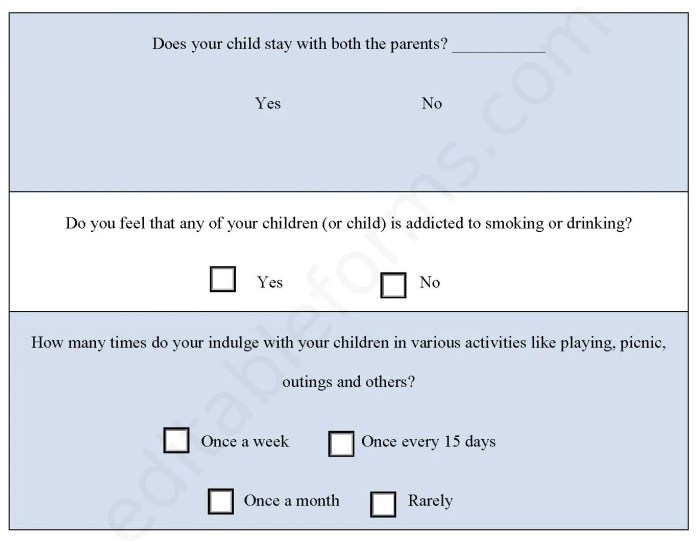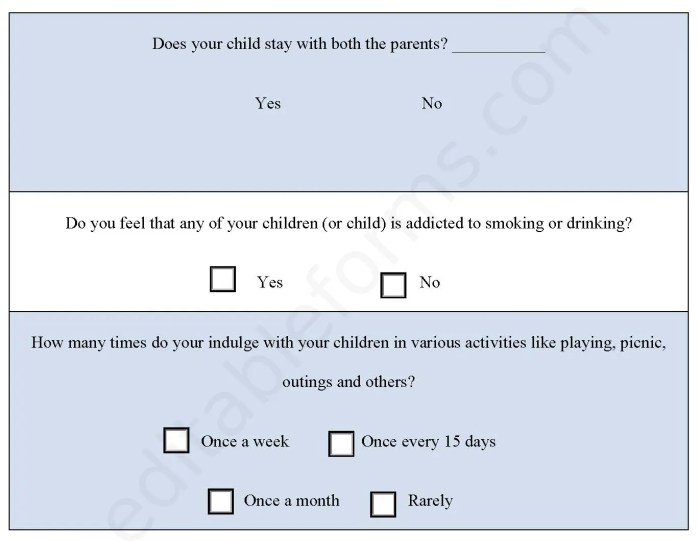Creating successful parent surveys is crucial for gathering valuable feedback and improving programs or services. This guide dives deep into the process, from defining clear objectives to analyzing results and implementing actionable improvements. We’ll explore the key elements for crafting effective questions, structuring engaging surveys, and collecting meaningful data. Understanding the nuances of parent perspectives and tailoring the survey experience is paramount to achieving positive outcomes.
This comprehensive guide covers everything from determining survey goals and crafting impactful questions to analyzing data and implementing changes. We’ll examine various strategies for increasing response rates, ensuring data privacy, and addressing potential challenges. Ultimately, we aim to empower educators, administrators, and service providers to create surveys that effectively capture parent input and drive positive change.
Defining the Purpose of Parent Surveys
Parent surveys are a valuable tool for understanding and improving the experiences of children and families. They provide insights into various aspects of a child’s development, education, and well-being, enabling educators and administrators to tailor programs and services to better meet their needs. A well-designed survey can illuminate crucial feedback from the parent perspective, leading to more effective and responsive solutions.Effective parent surveys are more than just gathering data; they are about understanding the motivations and concerns of parents and using that understanding to make positive changes.
This means carefully defining the survey’s purpose and aligning its goals with the specific context and needs of the community or institution.
Reasons for Completing Parent Surveys
Parents may complete surveys for a variety of reasons, ranging from a desire to contribute to their child’s learning environment to a need to voice concerns or offer suggestions. Understanding these motivations is crucial for crafting surveys that resonate with parents and encourage participation. Some common reasons include:
- A desire to support their child’s development: Parents often want to be involved in their child’s educational journey and contribute to their overall well-being. Surveys can provide a structured platform for parents to share their perspectives on how to improve these aspects.
- A need to voice concerns or offer suggestions: Parents may have concerns about the curriculum, teaching methods, or resources available to their children. Surveys provide a safe and structured way for them to articulate these concerns and offer solutions.
- A commitment to community involvement: Many parents value contributing to the improvement of their community’s educational system. Surveys can allow them to offer insights that directly impact school programs and practices.
- A desire for transparency and communication: Parents often appreciate opportunities to understand how the school or daycare functions and how their input contributes to the overall decision-making process.
Goals Achieved Through Parent Surveys
The goals of a parent survey can vary greatly depending on the specific needs of the institution or program. These goals can encompass a wide range of objectives, from gathering feedback on existing programs to assessing parent satisfaction and identifying areas for improvement.
- Improving program quality: Surveys can provide crucial feedback on existing programs, identifying areas that need improvement or adjustments. This can lead to enhanced curriculum, more effective teaching methods, or improved facilities.
- Assessing parent satisfaction: Understanding parent satisfaction levels is essential for evaluating the overall effectiveness of a program. Surveys can assess parents’ contentment with various aspects of the program, providing valuable insights into what’s working and what needs attention.
- Identifying areas for improvement: Surveys can reveal specific areas where the program or school needs improvement, leading to targeted interventions and positive change.
- Gathering feedback on specific programs or initiatives: Surveys can be designed to focus on particular aspects of a program or initiative, providing specific data to evaluate its effectiveness.
Tailoring Survey Goals to Specific Needs
The specific goals of a survey should be tailored to the context in which it’s administered. For example, a survey for a preschool might focus on the quality of childcare and the educational activities, whereas a survey for a high school might focus on student support services and extracurricular opportunities. This careful tailoring ensures that the survey is relevant and effective in providing useful insights.
Examples of Successful Survey Objectives
- School Context: A school might use a survey to assess parent satisfaction with school communication methods, determine the effectiveness of after-school programs, or gather input on the school’s safety protocols.
- Daycare Context: A daycare might use a survey to collect feedback on the quality of meals, the educational activities provided, or parent satisfaction with the level of communication between staff and parents.
Comparing Survey Goals and Outcomes
| Survey Goal | Intended Outcome |
|---|---|
| Improving program quality | Enhanced curriculum, improved teaching methods, better facilities |
| Assessing parent satisfaction | Identification of strengths and weaknesses in the program, targeted improvements |
| Identifying areas for improvement | Specific recommendations for adjustments to programs, processes, or policies |
| Gathering feedback on specific programs/initiatives | Data-driven evaluation of program effectiveness, enabling informed decisions |
Crafting Effective Survey Questions
Crafting effective parent surveys hinges on clear, concise, and unbiased questions. These questions should be carefully designed to elicit meaningful data, allowing for a thorough understanding of parents’ perspectives and experiences. A well-structured survey can provide valuable insights into various aspects of the school or program, ultimately leading to improvements in policies, programs, and overall student well-being.Effective survey questions are the cornerstone of successful data collection.
They need to be tailored to the specific goals of the survey, ensuring that the responses accurately reflect the target population’s opinions and experiences. Carefully worded questions will help to minimize ambiguity and ensure that the data gathered is reliable and actionable.
Open-Ended Questions
Open-ended questions allow for detailed responses, offering valuable qualitative insights. These questions encourage parents to elaborate on their thoughts and experiences, providing richer data than simple yes/no answers.
- What are your biggest concerns regarding the school’s approach to student well-being?
- How could the school better support parents in navigating the academic challenges faced by their children?
- Please describe your overall satisfaction with the school’s communication strategies.
- In your opinion, what are the most impactful extracurricular activities offered by the school, and why?
These examples aim to draw out specific details and perspectives.
Closed-Ended Questions
Closed-ended questions, such as multiple choice and rating scales, are useful for gathering quantifiable data and facilitating comparisons. They are particularly helpful for large-scale surveys, as they can be easily analyzed statistically.
- On a scale of 1 to 5, with 1 being strongly disagree and 5 being strongly agree, how satisfied are you with the school’s extracurricular offerings? (1) Strongly Disagree (2) Disagree (3) Neutral (4) Agree (5) Strongly Agree
- Which of the following best describes your child’s overall experience in the school’s after-school program? (a) Excellent (b) Good (c) Fair (d) Poor (e) Unsatisfactory
- How often do you attend school events? (a) Never (b) Rarely (c) Sometimes (d) Often (e) Very Often
These examples demonstrate how structured responses can be used to generate statistical summaries and comparisons.
Avoiding Biased Questions
Biased or leading questions can skew the results of a survey. These questions suggest a particular answer, potentially influencing the respondents’ opinions. Avoid questions that imply a judgment or a preference.
Creating successful parent surveys requires a thoughtful approach. Think about how you can make the experience positive and engaging for parents, gathering valuable feedback. Just like WooCommerce’s rebrand, which offers lessons for gaining a competitive edge in the eCommerce world woocommerce rebrand offers lessons for gaining competitive edge , understanding your target audience and adapting your approach is key.
Ultimately, this translates to surveys that are both effective and appreciated, leading to better insights and stronger relationships with parents.
- Instead of: “Don’t you think the school’s new policy is a great improvement?”
- Try: “What are your thoughts on the recent changes to the school’s attendance policy?”
This shift focuses on neutral language and allows for a more objective response.
Clear and Concise Language
Using clear and concise language in survey questions is crucial for ensuring accurate responses. Ambiguous or complex wording can lead to misinterpretations and inaccurate data. Keep the questions simple and easy to understand.
- Instead of: “Please elaborate on your feelings regarding the overall curriculum structure and its alignment with current educational standards.”
- Try: “How well does the current curriculum prepare students for future academic endeavors?”
Clear language directly addresses the point and allows for a straightforward answer.
Question Types and Suitability
The following table illustrates how different question types can be tailored to specific survey objectives.
| Question Type | Description | Suitability |
|---|---|---|
| Open-Ended | Allows for detailed, qualitative responses. | Understanding perspectives, exploring opinions in depth. |
| Multiple Choice | Limits responses to predefined options. | Gathering quantifiable data, comparing preferences. |
| Rating Scales | Measures attitudes and opinions on a scale. | Assessing satisfaction, gauging agreement/disagreement. |
Structuring the Survey for Optimal Response Rates
Crafting a survey that yields meaningful data requires more than just well-phrased questions. The structure and design significantly impact response rates and the quality of the collected information. A thoughtfully designed survey is easier to complete, leading to more accurate and comprehensive insights.The layout and length of a survey are critical factors influencing a parent’s willingness to participate.
A poorly structured survey can lead to frustration and abandonment, resulting in incomplete or skewed data. A well-organized survey, on the other hand, encourages engagement and increases the likelihood of receiving valuable feedback.
Survey Length and Design
Effective survey length depends on the purpose and the depth of information sought. A short, focused survey is more likely to be completed than a lengthy one, particularly when dealing with busy parents. Prioritize essential questions and avoid unnecessary inquiries. Consider the time commitment required for completion and adjust the survey accordingly. If a survey is too long, respondents might lose focus or become fatigued, leading to inaccurate or incomplete responses.
Balancing the need for comprehensive data with respondent engagement is key. Consider using skip logic, where certain questions are only displayed based on prior responses, to further streamline the survey and tailor it to the individual respondent.
Visual Aids and Formatting
The visual presentation of a survey greatly impacts the user experience. Clear and concise formatting, along with visually appealing elements, can significantly improve completion rates. Use headings, subheadings, and bullet points to break down complex information and make the survey easier to navigate. Avoid cluttered layouts, excessive use of jargon, and complex formatting that can confuse or frustrate respondents.
Images, charts, and other visual aids can be helpful to enhance understanding and engagement, but use them strategically and avoid overwhelming the survey with visuals.
Strategies to Increase Response Rates
Several strategies can boost response rates, ensuring a higher return on the investment of time and resources in creating the survey. These include clear communication, explicit instructions, and time constraints. Clearly stating the survey’s purpose and the importance of their participation can motivate parents to contribute their insights. Offer incentives, such as a small gift card or a chance to win a prize, for completing the survey.
Clearly communicate the anticipated time commitment, and provide an estimated completion time for the survey. If a survey requires a specific timeframe for completion, setting that time constraint can increase the likelihood of completing the survey.
- Clear Communication: Communicate the survey’s purpose and importance to respondents to motivate participation. Explain how their responses will contribute to improvements in [relevant area, e.g., educational programs].
- Incentives: Offer incentives, such as a small gift card or a chance to win a prize, for completing the survey.
- Time Constraints: Specify the estimated completion time to manage expectations and encourage prompt responses. Consider setting a reasonable time limit for completing the survey.
Survey Flow for Easy Navigation
A well-structured survey flow ensures a smooth and intuitive experience for respondents. Organize questions logically and use clear transitions between sections. Employ skip logic, where appropriate, to customize the survey for individual respondents. Logical grouping of questions helps respondents maintain focus and efficiently navigate the survey. Provide clear instructions and guidance at the beginning of each section to help respondents understand the purpose and expectations of the section.
Pros and Cons of Different Survey Lengths and Formats
| Survey Length/Format | Pros | Cons |
|---|---|---|
| Short (5-10 minutes) | High completion rates, quick feedback, manageable for busy parents | Limited depth of information, potential for missing crucial insights |
| Medium (10-20 minutes) | Balanced approach, gathers more detailed information, provides a wider range of insights | Higher risk of respondent fatigue, potentially lower completion rates |
| Long (20+ minutes) | Detailed and comprehensive data, explores nuanced perspectives | Low completion rates, high risk of respondent fatigue, potentially overwhelming for parents |
| Multiple-choice | Easy to analyze, quick to complete | Limited in-depth insights, may not capture nuanced perspectives |
| Open-ended | Provides detailed insights, captures nuances in responses | Time-consuming to analyze, potentially difficult to categorize responses |
Collecting and Analyzing Survey Data
Successfully gathering and analyzing parent survey data is crucial for understanding their perspectives and needs. This step transforms raw responses into actionable insights, driving improvements in programs and services. Careful attention to secure data collection, organization, and analysis is essential for generating reliable and trustworthy findings.Thorough planning for data collection and analysis methods is vital to ensure that the insights derived from the survey are accurate, reliable, and meaningful.
Creating successful parent surveys requires careful planning, and avoiding the pitfalls of “low-effort” content is key. Think about how you can craft questions that are easy to understand and genuinely elicit useful feedback. After all, Google’s recent guidelines on low-effort content that looks good highlight the importance of quality over flashy presentation. Ultimately, your goal is to get actionable insights from parents, not just pretty-looking data.
Clear, concise questions and a thoughtful survey design are the cornerstones of effective parent surveys.
This process involves careful consideration of the security protocols, organizational structures, and analytical techniques to be employed. Understanding potential pitfalls in data entry and analysis is just as important as knowing the optimal strategies.
Secure Data Collection Methods
Data security is paramount when handling sensitive information from parents. Implementing secure methods for collecting survey data is essential. This involves using secure online platforms with robust encryption, password protection, and access controls. For paper surveys, consider using secure storage methods for the physical questionnaires. Furthermore, collecting data through secure online platforms reduces the risk of data breaches and unauthorized access.
Crafting effective parent surveys is all about understanding their needs and perspectives. Think of it like customer marketing, applying the principles of power of customer marketing to get valuable feedback. This insight helps tailor programs to better serve the needs of the children and, ultimately, creating successful parent surveys that yield actionable data.
Organizing and Storing Survey Responses, Creating successful parent surveys
Efficient organization of survey responses is key to making the data easily accessible and manageable. Responses should be categorized and stored in a structured format, potentially using a spreadsheet or database. Implementing clear naming conventions for files and folders, and creating a detailed data dictionary for the survey, can help in the long run. This structured approach facilitates future analysis and retrieval of specific data points.
Identifying and Addressing Data Entry Errors
Data entry errors can significantly affect the accuracy of survey results. Employing automated validation checks and quality control measures can help mitigate this risk. These measures should include reviewing responses for logical consistency and identifying outliers or inconsistencies in the data. Employing data entry checks can ensure the integrity of the data and the reliability of the findings.
Ensuring Data Privacy and Confidentiality
Protecting the privacy and confidentiality of parent responses is ethically imperative. Adhering to strict data privacy regulations, such as GDPR or CCPA, is crucial. Anonymizing data wherever possible and implementing secure storage protocols are important steps. Data should be stored securely and accessed only by authorized personnel.
Data Analysis Methods
- Descriptive Statistics: Summarizing and describing the collected data using measures like mean, median, mode, and standard deviation. These methods are valuable for understanding the general characteristics of the data and identifying trends or patterns. For example, descriptive statistics can reveal the average age of parents who participated in the survey, or the percentage of parents who feel a certain program is beneficial.
- Inferential Statistics: Drawing conclusions about a larger population based on a sample of survey responses. This approach can determine whether observed differences between groups are statistically significant or simply due to chance. Inferential statistics can help determine if there are significant differences in opinions between parents with different backgrounds, such as income level or education level.
- Qualitative Analysis: Analyzing open-ended survey questions and comments to identify recurring themes, patterns, and insights. This approach provides a richer understanding of the nuances and perspectives of parents. Examining free-response comments can offer deeper understanding and insights into parents’ needs and suggestions.
Illustrative Data Analysis Table
| Data Analysis Method | Description | Strengths |
|---|---|---|
| Descriptive Statistics | Summarizes and describes data using measures like mean, median, and mode. | Easy to understand, identifies central tendencies and distributions, provides a concise overview of the data. |
| Inferential Statistics | Draws conclusions about a population based on a sample. | Identifies statistically significant differences, helps generalize findings to a broader population, assesses the reliability of results. |
| Qualitative Analysis | Analyzes open-ended responses to identify themes and patterns. | Provides rich insights into perspectives and motivations, uncovers nuanced opinions and feedback, explores complexities in parent viewpoints. |
Utilizing Survey Results for Improvement: Creating Successful Parent Surveys

Turning parent survey data into meaningful improvements requires a structured approach. Simply collecting the data isn’t enough; the key lies in analyzing it to identify actionable insights and using those insights to enhance programs and services. This process transforms raw numbers into concrete steps for growth.Effective use of survey results fosters a stronger connection between the organization and its parents, leading to improved services and a more positive experience for everyone involved.
It’s a crucial step in ensuring that the programs and services meet the needs of the families they serve.
Examples of Using Survey Data for Program Improvement
Parent feedback can illuminate areas needing attention. For instance, if surveys reveal consistent concerns about after-school program hours, the organization can adjust schedules to better accommodate parent work schedules or childcare needs. Similarly, if parents express a desire for more diverse extracurricular activities, the program can explore new options and expand its offerings. A high volume of complaints about the quality of materials in a preschool program, for example, could lead to increased budgets and a more thorough vetting process for vendors.
Translating Survey Results into Actionable Insights
Data analysis is critical to extracting meaningful insights. First, identify trends and patterns within the responses. Are certain themes recurring? Are specific demographics expressing similar concerns? Next, prioritize the most significant issues.
For example, if a large number of parents express dissatisfaction with communication methods, address this concern before tackling less prevalent issues. Then, formulate concrete strategies to address the identified issues. If a recurring concern is a lack of parking, for example, a plan to secure additional parking could be devised and implemented.
Presenting Survey Results to Stakeholders
Presenting survey findings effectively is crucial for gaining buy-in and support for changes. Use visual aids, like charts and graphs, to present data clearly and concisely. Keep the language straightforward and avoid technical jargon. Clearly define the survey’s scope and the population it represents. For instance, use charts and graphs to show the percentage of parents expressing concerns about the quality of childcare facilities.
Explain how the data directly impacts the organization and its stakeholders. This will allow stakeholders to grasp the importance of addressing the issues raised by the survey.
Communicating Survey Findings to Parents
Transparency and open communication are key. Summarize the survey findings in a clear and concise manner, avoiding technical language. Share the results with parents through a variety of channels, such as email newsletters, parent-teacher meetings, or community forums. Include specific examples of how the organization is using the feedback to improve services. This might involve a follow-up email with concrete plans for addressing their feedback.
Also, encourage further input by asking parents to share their perspectives on proposed solutions.
Steps to Translate Survey Data into Meaningful Improvements
| Step | Description |
|---|---|
| 1. Data Collection | Collect and compile the survey data. |
| 2. Data Analysis | Identify trends, patterns, and priorities in the responses. |
| 3. Prioritization | Focus on the most significant issues based on frequency and impact. |
| 4. Strategy Development | Create actionable strategies to address the prioritized issues. |
| 5. Implementation | Put the strategies into action and monitor progress. |
| 6. Evaluation | Assess the impact of the implemented strategies and make adjustments as needed. |
Addressing Potential Challenges
Successfully implementing parent surveys hinges not just on crafting excellent questions but also on anticipating and mitigating potential obstacles. Parents, like all survey respondents, may face various hurdles that prevent them from fully participating. Understanding these potential challenges is crucial for maximizing response rates and ensuring the survey’s effectiveness.
Identifying Potential Obstacles to Survey Completion
Many factors can deter parents from completing a survey. Time constraints, competing priorities, and a lack of perceived importance are common obstacles. Parents might feel overwhelmed by the survey length or the complexity of the questions, potentially leading to abandonment. The survey format itself, such as a difficult-to-navigate interface or confusing instructions, can also contribute to low completion rates.
Finally, a lack of clarity about the survey’s purpose or the intended use of the results can disincentivize participation.
Strategies for Addressing Concerns About Privacy and Confidentiality
Ensuring privacy and confidentiality is paramount when conducting surveys involving sensitive information. Clearly stating how the data will be protected and used is vital. Explicitly outlining the security measures implemented to safeguard participant information builds trust and encourages honest responses. Anonymity or pseudonimization of responses, if feasible, can further reinforce the sense of privacy. Transparency in data handling procedures and a commitment to ethical data practices are essential for gaining parental trust.
Handling Negative Feedback or Concerns from Survey Participants
Addressing negative feedback or concerns constructively is crucial. It demonstrates a commitment to addressing participants’ needs and can even lead to valuable insights. Actively listening to feedback and using it to improve future surveys shows respect for respondents. Implementing mechanisms for participants to express concerns, such as an email address or feedback form, can encourage open communication.
It’s important to acknowledge and address valid concerns promptly, while remaining firm in maintaining survey integrity and purpose.
Ensuring the Survey Remains Unbiased and Fair
Maintaining an unbiased and fair survey is paramount to obtaining accurate and reliable data. Objective questions, avoiding leading questions, and ensuring a neutral tone are crucial elements. Using a clear and concise language accessible to all parents, regardless of their background or education level, promotes inclusivity and avoids alienating potential participants. If necessary, consider having the survey translated into multiple languages to reach a broader audience and maintain fairness.
Table of Potential Challenges and Solutions
| Potential Challenge | Possible Solution |
|---|---|
| Short survey attention spans | Keep survey concise, use clear and direct language, and provide clear instructions. |
| Concerns about privacy and confidentiality | Clearly communicate data security measures, anonymize responses where possible, and obtain explicit consent. |
| Negative feedback or concerns | Provide a mechanism for feedback, promptly address concerns, and use feedback to improve future surveys. |
| Unclear survey purpose | Clearly state the survey’s purpose and how the results will be used. |
| Survey length and complexity | Reduce survey length, simplify questions, and pilot test the survey with a small group of parents. |
Illustrative Examples of Parent Surveys
Creating successful parent surveys requires careful consideration of various formats and question types. Understanding the nuances of different approaches can significantly impact response rates and the quality of data collected. This section provides concrete examples to illustrate effective survey design.
Different Parent Survey Formats
Surveys can take various forms, each with its own advantages and disadvantages. Choosing the right format depends on the resources available and the desired level of engagement.
- Online Surveys: Online platforms offer a cost-effective and efficient way to reach a large number of parents. They often allow for immediate data collection and analysis. Tools like SurveyMonkey, Google Forms, and Qualtrics provide user-friendly interfaces and robust data management features. Online surveys can be easily customized and adapted to different devices, making them accessible to a wide range of parents.
- Paper-Based Surveys: In certain settings, paper-based surveys might be more appropriate. These surveys are suitable when online access is limited or when respondents prefer a tangible format. Care must be taken to ensure secure handling and efficient data entry, often requiring a designated person to collect and input the data. The data must be carefully scanned and verified.
Surveys Focusing on Various Aspects of Parenting
Parent surveys can address a wide range of parenting concerns and interests. Focusing on specific areas helps gather targeted data and inform tailored interventions.
- Support Systems: A survey can assess parents’ perceived support from family, friends, and community resources. Questions might cover the availability and accessibility of support networks, highlighting areas where parents feel unsupported. Such data can inform the development of community support programs or referral services.
- Resource Availability: Surveys can identify gaps in access to crucial parenting resources like childcare, educational programs, and mental health services. This allows for targeted resource allocation and the creation of more accessible support systems for parents.
Surveys Promoting Parental Engagement
Designing surveys that encourage parental engagement is key to maximizing participation and obtaining valuable feedback.
- Clear Purpose and Value: Clearly explaining how the survey data will be used to improve the program or service for parents fosters a sense of ownership and encourages participation. Providing a clear timeline for when results will be shared is important.
- Short and Focused Questions: Surveys with concise and straightforward questions are more likely to be completed. Complex or lengthy questionnaires may discourage participation. The survey should avoid unnecessary questions or jargon, and use clear and concise language.
Survey Implementation in Various Settings
The application of survey methods can vary greatly depending on the specific context. School settings, community centers, and healthcare facilities will each require tailored survey design.
- Schools: Surveys in schools can assess parental satisfaction with educational programs, extracurricular activities, and school policies. School administrators can use this data to improve school services and parental engagement.
- Community Centers: Community centers can use surveys to understand the needs and interests of families in the community. This can inform the development of programs and services tailored to the specific needs of the community.
- Healthcare Facilities: Surveys can assess the experiences and needs of parents utilizing healthcare services. Healthcare providers can use this information to improve the quality of care and support for families.
Comparative Analysis of Survey Examples
| Survey Example | Format | Focus | Strengths | Weaknesses |
|---|---|---|---|---|
| Online Support System Survey | Online | Parental support | Large-scale reach, quick data collection, cost-effective | Potential for low response rate if not incentivized, technical issues |
| Paper-Based Resource Availability Survey | Paper-Based | Resource accessibility | Tangible format for some parents, easy to administer in specific locations | Data entry and analysis can be time-consuming, limited reach |
| School Parental Engagement Survey | Online | School-related feedback | Facilitates participation from a large number of parents, can be tailored to school needs | Requires careful consideration of privacy policies |
Final Wrap-Up

In conclusion, crafting successful parent surveys requires a thoughtful approach encompassing clear objectives, well-designed questions, and a user-friendly structure. By considering various factors such as survey length, visual aids, and response rate strategies, we can optimize the process for gathering valuable insights. The ultimate goal is to create a survey experience that fosters open communication and drives improvements in programs and services.
The insights gleaned from parent surveys can be instrumental in shaping positive change and building stronger relationships within the community.






